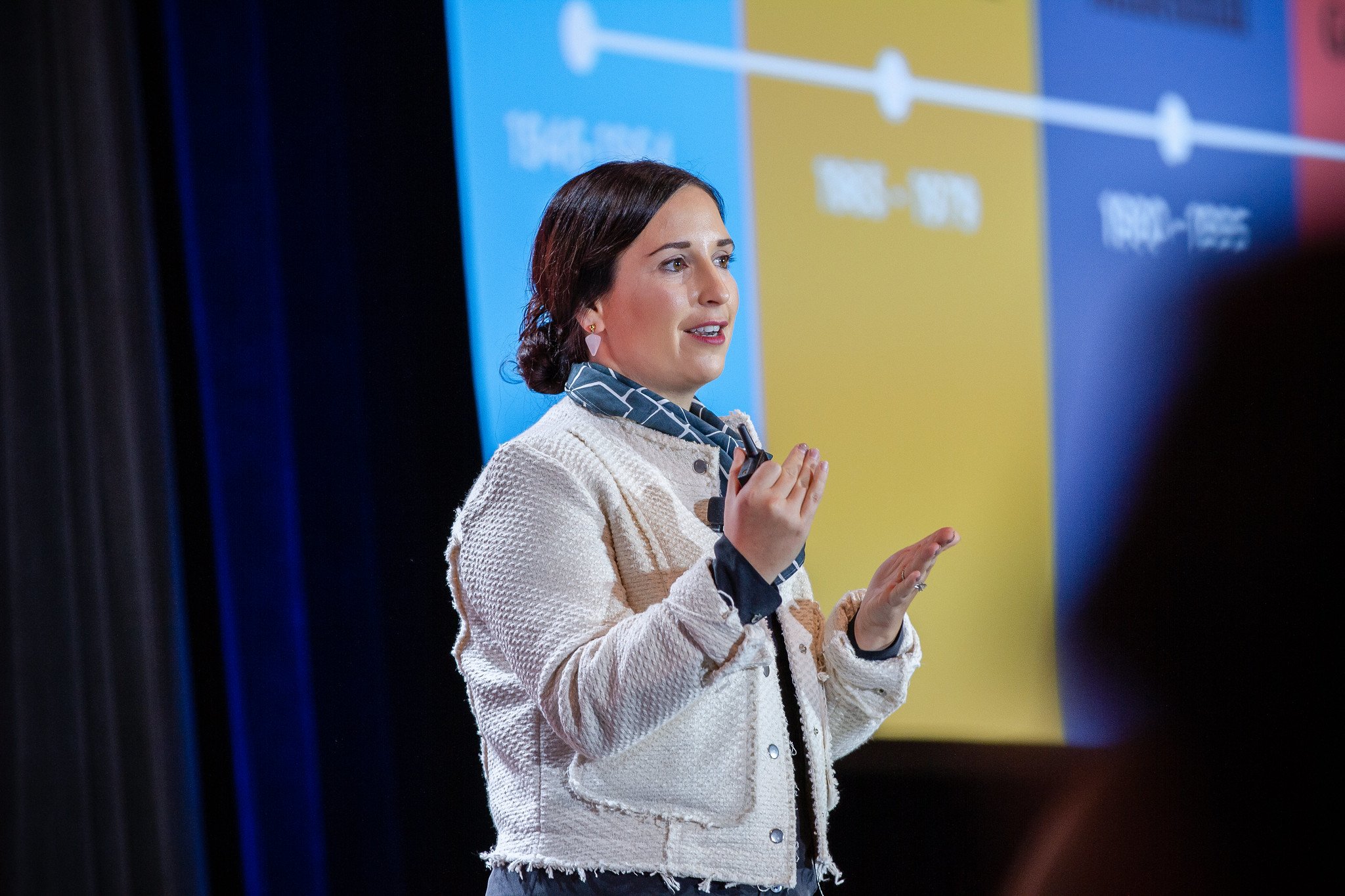There’s no doubt that every generation brings its own unique strengths and perceptions about work ethic and professionalism into the workforce. The result, however, is rarely a melting pot of intergenerational harmony: Relationships across generational lines can be fraught with miscommunication and frustration.
In healthcare facilities management, a wave of baby boomer retirements and a significant staffing shortage means that it’s more important than ever for leaders to have a deeper understanding of each generation’s motivations and characteristics. At HealthSpaces, generational expert Kim Lear broke down the essentials to help facilities execs strengthen relationships, become more effective leaders, and pass the torch in confidence.
Breaking Down Generational Barriers
According to Lear, generational tension is nothing new. However, catering to stereotypes or playing the blame game doesn’t benefit anyone. And while technology has fundamentally changed our relationship to work, Lear reminds us that the workplace has always been evolving.
"Understanding how to better communicate and collaborate with different generations benefits us all”
“First we worked on farms, then offices, and now that’s changing again. My goal isn’t to determine whose ‘right’ or tell baby boomers they must change everything about their work style to cater to Millennials. Part of it is making sure young employees understand how to work with their managers, too,” Lear said. “It’s to help us all adapt to the way things are now and create stronger relationships.”
Lear’s research focuses on the broad macro-trends that influence each generation’s formative teenage years. During this time in brain development, we’re coming to terms with the world around us—meaning that the cultural events that unfold during our adolescence have a lasting impact on how we view things like politics, money, risk, and, of course, behavior in the workplace.
“Ask a boomer about their first association with the word NASA, and you’ll see their eyes light up. They’ll talk about landing on the moon, and being raised with an optimistic ‘sky’s the limit’ view,” Lear said. “Ask a skeptical Gen Xer the same question, and you’ll hear about the let-down of the Challenger disaster.”
Lear believes it’s essential for all ages to be aware of our unique characteristics, strengths, and weaknesses to create a better culture.
“Older generations must be aware of hazing and let go of that. At the same time, younger generations also have to be cognizant of the sacrifices of their elders,” Lear said. "Holding onto stereotypes doesn’t benefit anyone. Understanding how to better communicate and collaborate with different generations, however, benefits us all.”
Lear then dove into the “need to know” information about today’s dominant workers: baby boomers, Gen Xers, Millennials, and Gen Zers.
Boomers: Born between 1946 and 1964
Baby boomers were shaped by cultural events like the Vietnam War, the assassination of JFK, the civil rights movement, and the moon landing.
“It’s very rare for generations to see the fruits of their labor. Typically, you work hard to create change and then die, and hope that your kids experience it. Boomers were the largest generation in American history and were slated to change the world, and in many ways they did,” Lear said.
Some of that optimism comes from that momentum from their youth culture, Lear explained. However, their large size had other implications, too: The American infrastructure wasn’t prepared for their arrival, resulting in a scarcity of classroom supplies, jobs, and even gas. This was reflected in a competitive spirit in the workplace; boomers went above and beyond the 40-hour work week, knowing full well that someone else could snatch up their job in a heartbeat.
This mindset tends to create friction today: For a boomer, staying late is a sign of a great work ethic. But for younger generations, it might seem inefficient.
“One thing the workforce is grappling with now is creating a culture where we focus on results rather than rules. How can we measure productivity rather than being obsessed with how they reach targets?” Lear said.
Another relevant issue is the baby boomer retirement wave. Retirement can be a time of emotional upheaval, Lear explained, that brings up big questions about relevancy and legacy (particularly for boomer men).
“We need to be having conversations that aren’t happening in the workplace: about reinvention, transformation, and the difficult things that come along with it,” Lear said. “Conversations about innovation tend to be Millennial-centric, but it’s about all of us. Young-at-heart boomers are redefining aging and retirement, and companies need to meet these expectations too.”
Lear discussed a tech company she has worked with which has taken an innovative approach to retirement. HR leaders gather execs who are retiring within a few years of each other for monthly discussion groups. Instead of just reviewing the basic logistics questions, the groups read thought-provoking books together and meet to talk about their next chapter in life.
“These boomers have a supportive community to lean on going through this transition. It changes their whole mindset: They feel like they are retiring to something, not just from something,” Lear said. “This creates more generous mentors who are more enthusiastic about succession planning and knowledge transfer.”

Gen X: Born between 1965 to 1980
Gen Xers arrived hot on the heels of the idealistic Baby Boomers. This cohort’s “skeptical” reputation stems from the emergence of 24/7 media, which called into question long-standing institutions like marriage and the American political system.
“The divorce rate tripled at this time, and we had a generation of latchkey kids who let themselves into empty homes after school. By age 20, they had watched 23,000 hours of TV and were sold to constantly,” Lear said. “This was before regulation—it was the Wild West of advertising.”
The “latchkey” generation grew into fiercely independent employees who are unfiltered and direct in their communications...and completely allergic to sugar-coating. In healthcare specifically, empowered Gen Xers have contributed significantly to the current paradigm shift.
“Doctors used to be considered oracles. Gen Xers are empowered with information and engaged in their own healthcare,” Lear said.
Gen Xers want work-life balance and prefer to get projects done in their own way (and alone, preferably). This independence can create tension between collaborative millennial employees, but Lear believes it all boils down to understanding each other’s communication styles.
“Gen Xers don’t really trust the system,” Lear said. “To work with them effectively, you need to anticipate and prepare for their skepticism. It’s a good sign if a Gen X employee is pushing you; it means they’re engaged.”
Lear’s advice for Gen Xers themselves follows a similar vein.
“If you’re a Gen Xer with this direct communication style, make sure your team understands that. Tell them, ‘If I’m poking holes in your ideas, it's not that I don't believe in you; I just want all the I’s dotted and the T’s crossed before we go further.’ Usually, that isn’t the conversation taking place. Make sure young people can prepare for your skepticism and work better for you.”
Millennials: Born between 1989 to 1995
Millennials, also known as the “Me” generation, came of age in a time of school violence, MySpace, Facebook, 9/11, and smartphones. In general, this cohort is in search of meaning, empowered, and networked.
“Part of the obsession with Millennials is that you have a generation that grew up with social media, and it changed absolutely everything: how we buy, sell, and date,” Lear explained. “ A bunch of kids with iPhones can change the financial situation of a huge organization within 24 hours.”
“Millennials grew up believing that adults were there to work with you, not against you”
A common complaint about Millennials is that they view authority as “equals.” It’s no surprise, however, when you zoom in on changes in the public education system during their formative years. Cluster-style seating is only half of the story. School guidance counselors came on to the scene, the self-esteem movement was raging, and Millennials had mentors, coaches, and teachers who told them that their voice mattered.
“Millennials grew up believing that adults were there to work with you, not against you,” Lear said. “They have uniquely close relationships with their Baby Boomer parents, who welcomed them back home after graduating from college.”
The emerging onramp to “adulthood” is another huge trend affecting this cohort. 30 isn’t what it used to be...which means there’s an influx of young people in the U.S. with the mind and wallet of an adult, but not the traditional responsibilities (mortgage, family, etc.). This welcomes time for freedom and introspection; Millennials are asking themselves the big questions early on, rather than during retirement. The rise of dual-income households has also affected the workforce; as the social construction of fatherhood has changed, men are leaving or taking jobs based on these realities.
“Millennials know they have potentially 50 years of work ahead of them, so they naturally want to be passionate about that work,” Lear shared. “This has changed the game for recruiting talent. Job-hunting used to mean, ‘Do I want this job?’ and now it’s ‘Do I want this life?’ Companies who can effectively tell and sell the story about the life provided by their jobs, culture, and organization will be successful in recruiting and retaining Millennials.”
Gen Z: Born 1996 to 2010 (ish)
Lear briefly touched on Gen Z, mentioning that the research is preliminary since this group is still in the midst of their formative years. Its oldest members, however, have begun to enter the workforce, so Lear shared some essential information about our nation’s youngest employees.
Socially Conscious
According to Lear, American companies can no longer afford to be neutral because it’s a “bad recruitment tactic” for socially-conscious Gen Zers. “Young people want to know what you stand for. They grew up in a time where politics isn’t about policy; it’s about morality and ethics. They are more inclined to join your organization if your values align,” she said.
Diversity
Gen Z is the most diverse generation to date, meaning that inclusive company cultures are necessary for future-facing organizations. “When it comes to recruiting and retaining the next generation of talent, they will look different. How are you being intentional about bringing diverse voices to the table?” Lear said.
Fiercely Competitive
Millennials may have been reared during the self-esteem movement, but Gen Z grew up with a more realistic, pragmatic style of parenting. Gen Zers are cognizant of the fact that they’re competing with talent from all over the globe. “They realize they’re up against a different set of competition, and this group is entrepreneurial and hard-working. Gen Z will bring that fire and competitive spirit into the marketplace,” Lear said.
Conclusion
At the end of the day, each generation brings a different dynamic to the table. When healthcare leaders deepen their understanding of these unique characteristics, it not only harnesses the potential of each employee but benefits the company culture as a whole.
Join us at HealthSpaces'19 to learn more about the latest innovations in healthcare facilities planning, design, construction & operations.

Posted by
Collaborate with your Peers!
HealthSpaces is a community for people that plan, design, build and operate spaces where healthcare is delivered.
June 7-9, 2026 | Braselton, GA
Learn More




-4.png)
-Dec-09-2025-05-48-44-4379-PM.png)
-4.png)
-1.png)
-2.png)

Comments